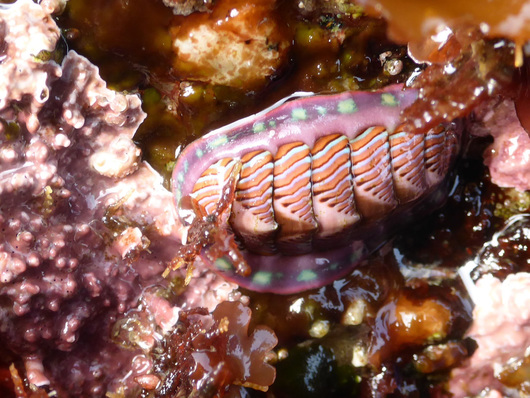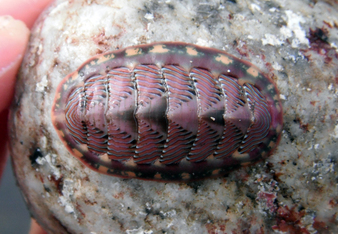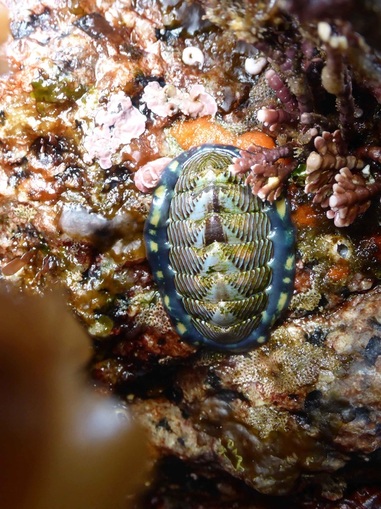Lined chiton, red-lined chiton • Tonicella lineata
Identification
The patterning and bright colours of this chiton are fairly distinctive, though the colours of both the smooth, hairless girdle and the patterned plates can be highly variable. Often the girdle is darker, with white, yellow, or orange blocks creating a banded or spotted appearance. The edge of the girdle may be lined with a brighter colour. The plates have wavy or zig-zagging lines of blue, pink, red, black or white, mostly on the sides of the plates; these lines appear diagonal on the middle plates (2-7) and concentric on the head and tail plates. This chiton is relatively small, reaching only 5 cm in length.
Habitat & Range
The lined chiton is commonly found in low intertidal and subtidal rocky areas - particularly those covered in coralline algae, its favourite food. It can be found from the Aleutian Islands south to the Channel Islands in California. It has also been reported in the Sea of Okhotsk in northern Japan.
Similar Species
The blue-lined chiton (Tonicella undocaerulea), which is similarly patterned on its plates and girdle, has bright blue wavy lines as part of its plate pattern (these lines quickly fade to white in preserved specimens). Given the lined chiton's variability in colour, the most consistent way to differentiate these species is by looking at the anterior head plate (the head is the end from which the plates curve slightly away). On the lined chiton the wavy concentric lines on the anterior plate are bordered by thin dark brown lines; these dark brown lines are absent on the blue-lined chiton's anterior plate.
Intriguing Info
Lined chitons are preyed upon by ochre stars and six ray stars. They often live in the rock depressions created by purple sea urchins - sometimes underneath the urchins themselves.
The patterning and bright colours of this chiton are fairly distinctive, though the colours of both the smooth, hairless girdle and the patterned plates can be highly variable. Often the girdle is darker, with white, yellow, or orange blocks creating a banded or spotted appearance. The edge of the girdle may be lined with a brighter colour. The plates have wavy or zig-zagging lines of blue, pink, red, black or white, mostly on the sides of the plates; these lines appear diagonal on the middle plates (2-7) and concentric on the head and tail plates. This chiton is relatively small, reaching only 5 cm in length.
Habitat & Range
The lined chiton is commonly found in low intertidal and subtidal rocky areas - particularly those covered in coralline algae, its favourite food. It can be found from the Aleutian Islands south to the Channel Islands in California. It has also been reported in the Sea of Okhotsk in northern Japan.
Similar Species
The blue-lined chiton (Tonicella undocaerulea), which is similarly patterned on its plates and girdle, has bright blue wavy lines as part of its plate pattern (these lines quickly fade to white in preserved specimens). Given the lined chiton's variability in colour, the most consistent way to differentiate these species is by looking at the anterior head plate (the head is the end from which the plates curve slightly away). On the lined chiton the wavy concentric lines on the anterior plate are bordered by thin dark brown lines; these dark brown lines are absent on the blue-lined chiton's anterior plate.
Intriguing Info
Lined chitons are preyed upon by ochre stars and six ray stars. They often live in the rock depressions created by purple sea urchins - sometimes underneath the urchins themselves.
References
Baldwin, A. (2007). Tonicella lineata (Red-Lined Chiton). In Klinkenberg, Brian. (Ed.) E-Fauna BC: Electronic Atlas of the Fauna of British Columbia. Lab for Advanced Spatial Analysis, Department of Geography, University of British Columbia, Vancouver. Accessed 30/06/2016.
Cowles, D. (2005). Tonicella lineata (Wood, 1815). Invertebrates of the Salish Sea. Rosario Beach Marine Laboratory. Accessed 08/062013.
Harbo, R. M. (1997) Shells & Shellfish of the Pacific Northwest. Madeira Park, BC: Harbour Publishing. P. 227.
Authors and editors of page
Kelly Fretwell and Brian Starzomski (2013).
Baldwin, A. (2007). Tonicella lineata (Red-Lined Chiton). In Klinkenberg, Brian. (Ed.) E-Fauna BC: Electronic Atlas of the Fauna of British Columbia. Lab for Advanced Spatial Analysis, Department of Geography, University of British Columbia, Vancouver. Accessed 30/06/2016.
Cowles, D. (2005). Tonicella lineata (Wood, 1815). Invertebrates of the Salish Sea. Rosario Beach Marine Laboratory. Accessed 08/062013.
Harbo, R. M. (1997) Shells & Shellfish of the Pacific Northwest. Madeira Park, BC: Harbour Publishing. P. 227.
Authors and editors of page
Kelly Fretwell and Brian Starzomski (2013).






